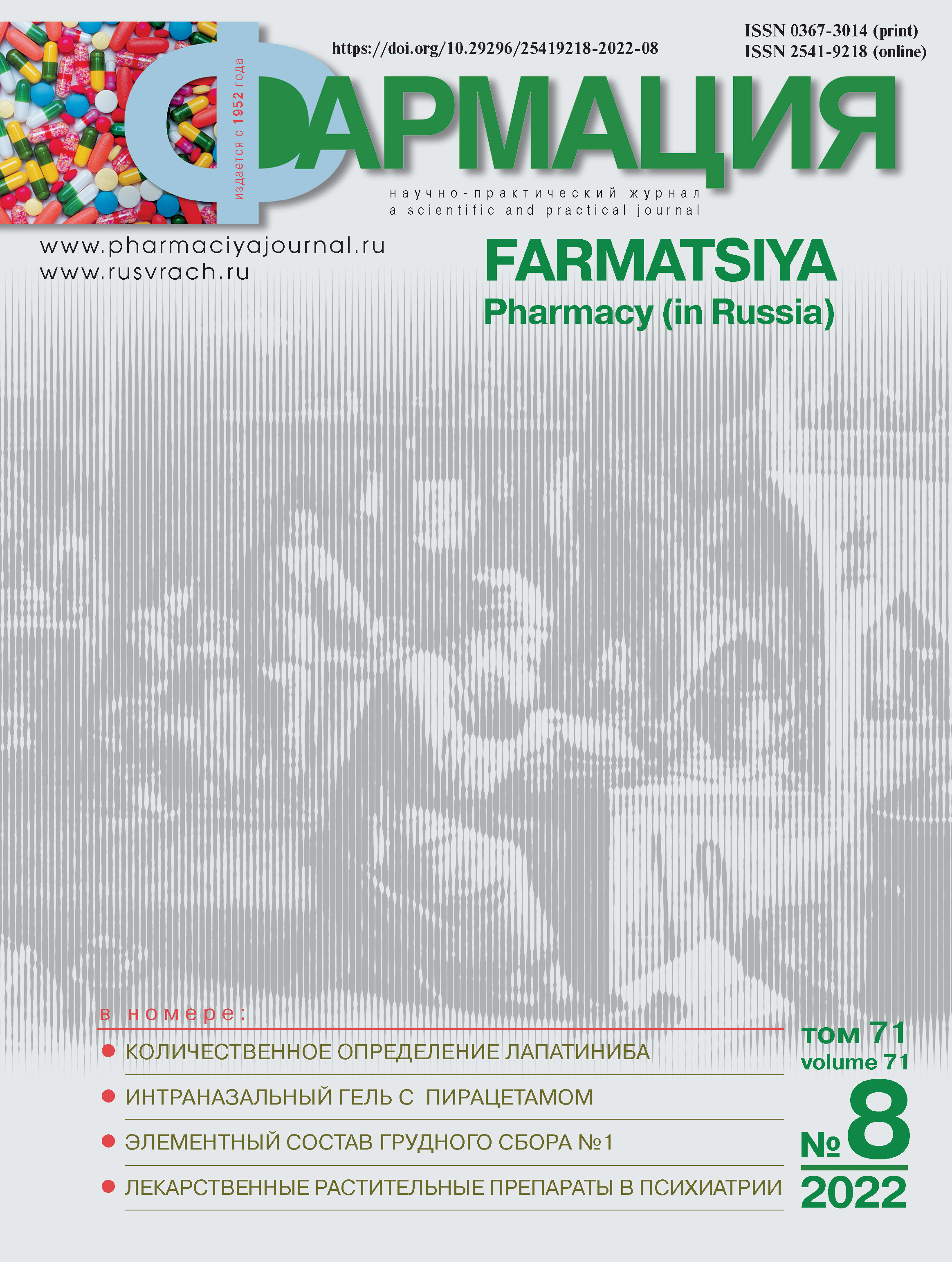Elemental composition of pectoral species No. 1 and its components
- 作者: Kakhramanova S.D.1,2, Bokov D.O.1,3, Gravel I.V.1, Samylina I.A.1
-
隶属关系:
- Sechenov First Moscow State Medical University (Sechenov University)
- Federal State Budgetary Institution Scientific Center for Expertise of Medicinal Products
- Federal State Budgetary Scientific Institution “Federal Research Center of Nutrition and Biotechnology”
- 期: 卷 71, 编号 8 (2022)
- 页面: 21-27
- 栏目: Pharmaceutical chemistry and pharmacognosy
- URL: https://bakhtiniada.ru/0367-3014/article/view/144031
- DOI: https://doi.org/10.29296/25419218-2022-08-03
- ID: 144031
如何引用文章
详细
Introduction. Medicinal herbal preparations are very popular in the complex therapy of various diseases. Many medicinal plants are able to concentrate mineral elements. Knowledge of the content of macro- and microelements in plants makes it possible to purposefully use them for the prevention and treatment of human microelementoses. Also, to assess the safety of herbal medicines, it is necessary to monitor the content of toxic elements in plant raw materials and the transition of toxic elements from raw materials to aqueous extracts.
Objectives: study of pectoral species No.1 and its components mineral elements composition and contamination with toxic elements.
Material and methods. Samples of pectoral species No.1 and its components – marshmallow roots, oregano herb, coltsfoot leaves (manufacturer: Krasnogorskleksredstva JSC) were purchased at Moscow’s pharmacy and used for analysis. The elemental composition of pectoral species No. 1 and its components was determined by inductively coupled plasma mass spectrometry (ICP-MS).
Results. 29 elements were found in pectoral species No. 1 and its components. Potassium, calcium, magnesium, sodium, aluminum, iron, strontium, zinc, manganese are the predominant elements of pectoral species No. 1 and its components.
Conclusion. The high content of potassium, calcium and magnesium in the pectoral species No. 1 can be explained by the high content of these elements in each component. The content of heavy metals in the pectoral species No. 1 and its components did not exceed the maximum permissible concentration.
作者简介
Sabina Kakhramanova
Sechenov First Moscow State Medical University (Sechenov University); Federal State Budgetary Institution Scientific Center for Expertise of Medicinal Products
编辑信件的主要联系方式.
Email: ksd113@yandex.ru
ORCID iD: 0000-0002-8160-7829
PhD student in pharmaceutical sciences of the Pharmaceutical Natural Sciences Department at Sechenov University
st. Trubetskaya, 8, bldg. 2, Moscow, 119991, Russian Federation; Petrovsky Boulevard, 8, bldg. 2, Moscow, 127051, Russian FederationDmitry Bokov
Sechenov First Moscow State Medical University (Sechenov University); Federal State Budgetary Scientific Institution “Federal Research Center of Nutrition and Biotechnology”
Email: bokov_d_o@staff.sechenov.ru
ORCID iD: 0000-0003-2968-2466
PhD in pharmaceutical sciences, associate professor of the Pharmaceutical Natural Sciences Department at Sechenov University; researcher of laboratory of chemistry of food products at the Federal State Budgetary Scientific Institution “Federal Research Center of Nutrition and Biotechnology”
st. Trubetskaya, 8, bldg. 2, Moscow, 119991, Russian Federation; Ustinsky proezd, building 2/14, Moscow, 109240, Russian FederationIrina Gravel
Sechenov First Moscow State Medical University (Sechenov University)
Email: gravel_i_v@staff.sechenov.ru
ORCID iD: 0000-0002-3735-2291
Doctor of Pharmaceutical Sciences, Professor, Professor of the Pharmaceutical Natural Sciences Department at Sechenov University
st. Trubetskaya, 8, bldg. 2, Moscow, 119991, Russian FederationIrina Samylina
Sechenov First Moscow State Medical University (Sechenov University)
Email: samylina_i_a@staff.sechenov.ru
ORCID iD: 0000-0002-4895-0203
Doctor of Pharmaceutical Sciences, corresponding member of the RAS, Professor, professor of the Pharmaceutical Natural Sciences Department at Sechenov University
俄罗斯联邦, st. Trubetskaya, 8, bldg. 2, Moscow, 119991, Russian Federation参考
- Gravel I.V., Shoikhet Ya.N., Yakovlev G.P., Samylina I.A. Pharmacognosy. Ecotoxicants in crude herbal drugs and herbal drugs: textbook. M.: GEOTAR-media, 2012; 304.
- State Register of Medicines. The Russian Federation Ministry of Health [Official site]. URL: https://grls.rosminzdrav.ru/ (in Russian).
- Chizzola R. Metallic mineral elements and heavy metals in medicinal plants. Medicinal and aromatic plant science and biotechnology. 2012; 6 (1): 39–53.
- Potortì A.G., Turco V.L., Di Bella G. Chemometric analysis of elements content in Algerian spices and aromatic herbs. LWT. 2021; 138: 110643.
- Szentmihályi K., May Z., Then M., Hajdú M. et al. Metal elements, organic agents in herbal remedy, Species thymi composite, and its drug-constituents. Eur. Chem. Bull. 2012; 1: 14–21.
- Ghosh J., Midday M., Maity D. Tussilago farfara L., a promising ethnomedicinal plant of Sikkim. Exploratory Anim Med Res. 2017; 7 (1): 100–3.
- Foisner V. The relationship between plants and minerals–co-occurrences, uptake strategies, and indicator plants. Salzburg 2021 1–78. [Electronic resource]. Access mode: https://akjournals.com/view/journals/650/154/14/article-p538.xml
- Živkov-Baloš M. et al. Determination of some essential elements in herbal teas from Serbia using atomic spectrometry (AAS). Savremena poljoprivreda. 2014; 63 (4–5): 394–402.
- Zykova I.D., Efremov A.A. Mineral composition of aboveground organs of Filipendula Ulmaria (l) Maxim. Siberian Medical J. (Irkutsk). 2012; 114 (7): 103–5.
- Gravel I.V., Levushkin D.V., Mikheev I.V., Skibina A.A. The content of macronutrients in the pectoral species No. 4. Traditional medicine. 2021; 3 (66): 19–26.
- Galenko M.S., Gravel I.V., Velts N.Yu., Alyautdin R.N. Rationing of the heavy metals and arsenic content as a safety factor for the herbal drugs use. Safety and risk of pharmacotherapy. 2021; 9 (2): 61–8.
- Popova E.N., Ponomareva L.A., Gravel I.V. Features of cough during a pandemic. Academy of Medicine and Sports. 2021; 2 (4): 37-40 [In Russian].
- Levushkin D.V., Gravel I.V. Multicomponent drug preparations as a source of macronutrients. Bulletin of Pharmacy. 2021; 4: 94 [In Russian].
- Gravel I.V. et al. The content of macroelements in pectoral species No. 4 // Traditional medicine. 2021; 3: 19-26 [In Russian].
- GPM.1.5.3.0009.15 "Determination of the content of heavy metals and arsenic in medicinal plant raw materials and medicinal herbal preparations". State Pharmacopoeia of the Russian Federation. XIV ed.; 2018 [In Russian].












